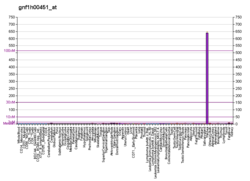BPI fold-containing family B member 2
| BPIFB2 | |||||||||||||||||||||||||
|---|---|---|---|---|---|---|---|---|---|---|---|---|---|---|---|---|---|---|---|---|---|---|---|---|---|
| Identifiers | |||||||||||||||||||||||||
| Aliases | BPIFB2, BPIL1, C20orf184, LPLUNC2, RYSR, dJ726C3.2, BPI fold containing family B member 2 | ||||||||||||||||||||||||
| External IDs | MGI: 1913807 HomoloGene: 11884 GeneCards: BPIFB2 | ||||||||||||||||||||||||
| |||||||||||||||||||||||||
| |||||||||||||||||||||||||
| |||||||||||||||||||||||||
| |||||||||||||||||||||||||
| Orthologs | |||||||||||||||||||||||||
| Species | Human | Mouse | |||||||||||||||||||||||
| Entrez | |||||||||||||||||||||||||
| Ensembl | |||||||||||||||||||||||||
| UniProt | |||||||||||||||||||||||||
| RefSeq (mRNA) | |||||||||||||||||||||||||
| RefSeq (protein) | |||||||||||||||||||||||||
| Location (UCSC) | Chr 20: 33.01 – 33.02 Mb | Chr 2: 153.88 – 153.9 Mb | |||||||||||||||||||||||
| PubMed search | [3] | [4] | |||||||||||||||||||||||
| Wikidata | |||||||||||||||||||||||||
| |||||||||||||||||||||||||
BPI fold-containing family B member 2 (BPIFB2) also known as bactericidal/permeability-increasing protein-like 1 (BPI-like 1) is a protein that in humans is encoded by the BPIFB2 gene.[5][6]
Function
This gene encodes a member of the lipid transfer/lipopolysaccharide binding protein (LT/LBP) gene family. It is highly expressed in hypertrophic tonsils. This gene and three other members of the LT/LBP gene family form a cluster on the long arm of chromosome 20.[6]
References
- 1 2 3 GRCh38: Ensembl release 89: ENSG00000078898 - Ensembl, May 2017
- 1 2 3 GRCm38: Ensembl release 89: ENSMUSG00000027481 - Ensembl, May 2017
- ↑ "Human PubMed Reference:".
- ↑ "Mouse PubMed Reference:".
- ↑ Mulero JJ, Boyle BJ, Bradley S, Bright JM, Nelken ST, Ho TT, Mize NK, Childs JD, Ballinger DG, Ford JE, Rupp F (Aug 2002). "Three new human members of the lipid transfer/lipopolysaccharide binding protein family (LT/LBP)". Immunogenetics. 54 (5): 293–300. doi:10.1007/s00251-002-0467-3. PMID 12185532.
- 1 2 "Entrez Gene: BPIL1 bactericidal/permeability-increasing protein-like 1".
External links
- Human BPIFB2 genome location and BPIFB2 gene details page in the UCSC Genome Browser.
Further reading
- Bingle CD, Bingle L (2000). "Characterisation of the human plunc gene, a gene product with an upper airways and nasopharyngeal restricted expression pattern". Biochim. Biophys. Acta. 1493 (3): 363–7. doi:10.1016/S0167-4781(00)00196-2. PMID 11018263.
- Bingle CD, Craven CJ (2003). "PLUNC: a novel family of candidate host defence proteins expressed in the upper airways and nasopharynx". Hum. Mol. Genet. 11 (8): 937–43. doi:10.1093/hmg/11.8.937. PMID 11971875.
- Zhang Z, Henzel WJ (2005). "Signal peptide prediction based on analysis of experimentally verified cleavage sites". Protein Sci. 13 (10): 2819–24. doi:10.1110/ps.04682504. PMC 2286551. PMID 15340161.
- Ramachandran P, Boontheung P, Xie Y, et al. (2006). "Identification of N-linked glycoproteins in human saliva by glycoprotein capture and mass spectrometry". J. Proteome Res. 5 (6): 1493–503. doi:10.1021/pr050492k. PMID 16740002.
This article is issued from
Wikipedia.
The text is licensed under Creative Commons - Attribution - Sharealike.
Additional terms may apply for the media files.




